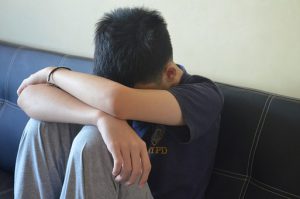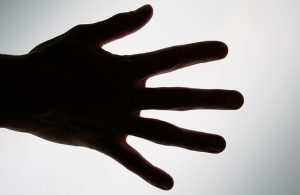Friday
Featured StoriesGiving the Ghost a Voice, Part II
Sharing a personal experience of racial identity as an Asian American Buddhist
by Bryan Mendiola
There is one important caveat: I don’t know how to talk about race. The term Asian American was never spoken in my home growing up, and this quietly implied that it should not be talked about, that this was not how we should think of ourselves. In contrast, there was never any doubt that we were Filipino. This was celebrated and honored through food, family, religion, and community. These were the cultural waters we swam in. But race was on the periphery, like a ghost that no one wanted to name or acknowledge. Even as I write this, I feel my anxiety well up over being misunderstood or being misperceived as representing more than myself alone in my views. I even struggle with whether or not my story is really about race or deserves a place in a dialogue about race. But, before I had any words for race in early adolescence, my experience was about sadness, loneliness, and depression. And however uncomfortably, I do know how to talk about those things.
 My depression was rooted in never finding a place to call home. There was a perpetual sense of not belonging anywhere, never quite fitting in, even in my own supposed social groups. I often felt too Asian to feel completely a part of the white suburbs that surrounded us, and too white or too American to be fully integrated into Asian communities or other communities of color—even into my own family at times. I longed to be able to look into the world of television and magazines to see and hear someone who looked like me, talked and thought like me, and could give me an example of what I could become. In my young mind, the only way I could make sense of a world that didn’t have “me” in it was that “me” didn’t matter.
My depression was rooted in never finding a place to call home. There was a perpetual sense of not belonging anywhere, never quite fitting in, even in my own supposed social groups. I often felt too Asian to feel completely a part of the white suburbs that surrounded us, and too white or too American to be fully integrated into Asian communities or other communities of color—even into my own family at times. I longed to be able to look into the world of television and magazines to see and hear someone who looked like me, talked and thought like me, and could give me an example of what I could become. In my young mind, the only way I could make sense of a world that didn’t have “me” in it was that “me” didn’t matter.
 And so I quietly began to tear myself apart—feeling tortured by who I was and what I looked like. This is a nuanced and slippery, but hallmark, feature of my own experience of being Asian American. My painful experiences around race feel less about overt acts of racism and discrimination, less about systemic injustices, and more about a perpetual experience of feeling unseen and silenced. One of the great challenges in finding a voice in the dialogue of race is that, as an Asian American, it is remarkably difficult to name the “problem,” because it is one more of absence than presence. It feels less a problem of having an identity undermined or marginalized, and more a problem of not having an identity—visible, coherent, or identifiable—in the first place.
And so I quietly began to tear myself apart—feeling tortured by who I was and what I looked like. This is a nuanced and slippery, but hallmark, feature of my own experience of being Asian American. My painful experiences around race feel less about overt acts of racism and discrimination, less about systemic injustices, and more about a perpetual experience of feeling unseen and silenced. One of the great challenges in finding a voice in the dialogue of race is that, as an Asian American, it is remarkably difficult to name the “problem,” because it is one more of absence than presence. It feels less a problem of having an identity undermined or marginalized, and more a problem of not having an identity—visible, coherent, or identifiable—in the first place.
 In my experience, there are many factors that contribute to this sense of invisibility. While never directly stated, the perceived message from my Asian and Asian American communities is that I’m not supposed to have a distinct voice in sharing who I am and what my life is about. There is a natural inclination toward a collective mindset and to gauge properly whether or not my experience appropriately represents the collective—a compulsive checking in with the group for approval and permission. And the implicit message from the group is: “Don’t speak for the rest of us—especially if you’re going to talk about our problems.” I was often left feeling alone and voiceless as an Asian American, without clear role models in the media or popular culture, and I was given few historical figures of social change to identify with. Even widely known Asians in history who represented social causes have been marked by a seemingly stereotypical passivity, meekness, or unemotionality, qualities that I did not wish to embody in my own life. Moreover, there was no singular, tangible source of injustice that spoke to my experience as an Asian American. As a first-generation Asian American, I grew up with significant economic and academic privilege. Issues of money and education were never at the forefront of my struggles, which often left me wondering if my own suffering was even justified or valid.
In my experience, there are many factors that contribute to this sense of invisibility. While never directly stated, the perceived message from my Asian and Asian American communities is that I’m not supposed to have a distinct voice in sharing who I am and what my life is about. There is a natural inclination toward a collective mindset and to gauge properly whether or not my experience appropriately represents the collective—a compulsive checking in with the group for approval and permission. And the implicit message from the group is: “Don’t speak for the rest of us—especially if you’re going to talk about our problems.” I was often left feeling alone and voiceless as an Asian American, without clear role models in the media or popular culture, and I was given few historical figures of social change to identify with. Even widely known Asians in history who represented social causes have been marked by a seemingly stereotypical passivity, meekness, or unemotionality, qualities that I did not wish to embody in my own life. Moreover, there was no singular, tangible source of injustice that spoke to my experience as an Asian American. As a first-generation Asian American, I grew up with significant economic and academic privilege. Issues of money and education were never at the forefront of my struggles, which often left me wondering if my own suffering was even justified or valid.
 And yet, I felt it—as real and as true as anything in my life. At the heart of my struggles as an Asian American has been a tremendous internal conflict, if not an external one. This conflict within is built around a profound and unrealistic pressure to succeed at a societal game I might not even feel a part of, but that may be the chief means by which I judge my own worth. At the end of the day, when the game is not being played, maybe I’m the one who doesn’t have a home to go back to. I can adapt and blend in just enough to get by, but never enough to actually belong. So maybe I end up belonging only to the game itself—only to an illusion—even if it’s not one I value, agree with, or buy into. Perhaps because I can play it, I never stop to ask myself if I should play it. And what seems to be the fallout is an invisible experience of suppressed frustration, passive-aggressive competition, hidden identity crises, and underlying emotional turmoil: a powerful storm brewing just under the surface of a peaceful, calm façade.
And yet, I felt it—as real and as true as anything in my life. At the heart of my struggles as an Asian American has been a tremendous internal conflict, if not an external one. This conflict within is built around a profound and unrealistic pressure to succeed at a societal game I might not even feel a part of, but that may be the chief means by which I judge my own worth. At the end of the day, when the game is not being played, maybe I’m the one who doesn’t have a home to go back to. I can adapt and blend in just enough to get by, but never enough to actually belong. So maybe I end up belonging only to the game itself—only to an illusion—even if it’s not one I value, agree with, or buy into. Perhaps because I can play it, I never stop to ask myself if I should play it. And what seems to be the fallout is an invisible experience of suppressed frustration, passive-aggressive competition, hidden identity crises, and underlying emotional turmoil: a powerful storm brewing just under the surface of a peaceful, calm façade.
 Put simply, what depression and race largely meant to me during those formative years of my life was an experience of self-hatred. Hatred of the shape of my lips and nose, the coloration of my skin, the lack of proper physique, or the hair that would never quite look like a white person’s. Hatred of the way I talked or never talked. Hatred of my self-consciousness and lack of confidence, as well as of my pretending to be confident. Hatred for always feeling alone, regardless of how many friends I had or how much family or community surrounded me. Hatred for even the ways that I was loved by others, because I knew in my heart that their love was misplaced. Hatred of my constant comparisons to others, even within my social circles, because I, too, succumb to the pressure to succeed and perform and perfect myself. Hatred toward this life of mine in which there was no other person in the world mirroring back some clear semblance of myself and my experience. Hatred, at times, of myself for wanting to give up on life altogether.
Put simply, what depression and race largely meant to me during those formative years of my life was an experience of self-hatred. Hatred of the shape of my lips and nose, the coloration of my skin, the lack of proper physique, or the hair that would never quite look like a white person’s. Hatred of the way I talked or never talked. Hatred of my self-consciousness and lack of confidence, as well as of my pretending to be confident. Hatred for always feeling alone, regardless of how many friends I had or how much family or community surrounded me. Hatred for even the ways that I was loved by others, because I knew in my heart that their love was misplaced. Hatred of my constant comparisons to others, even within my social circles, because I, too, succumb to the pressure to succeed and perform and perfect myself. Hatred toward this life of mine in which there was no other person in the world mirroring back some clear semblance of myself and my experience. Hatred, at times, of myself for wanting to give up on life altogether.
 Bryan Mendiola is a Filipino/Asian American psychologist and a student of Shambhala Buddhism. He lives with his wife and son in Western Massachusetts.
Bryan Mendiola is a Filipino/Asian American psychologist and a student of Shambhala Buddhism. He lives with his wife and son in Western Massachusetts.
Editor’s note: this story was previously published in the Harvard Divinity Bulletin, and is reprinted here by permission of the author. It was part of a segment on engaged Buddhism as a follow-up to the Buddhism and Race Conference at Harvard Divinity School in March of 2015. Videos are available online from the March 2015 conference (http://hds.harvard.edu/news/2015/03/06/video-buddhism-and-race-america-intra-sangha-racial-dynamics) as well as the April 2016 conference (http://hds.harvard.edu/news/2016/04/23/video-challenges-being-poc-largely-white-sanghas).






May 20, 2016
Reply
Thank you Bryan for such a personal account of your struggle and for opening the conversation even wider. I suspect there are many people within our community, as there are in the world at large, who feel “unseen and silenced”. You opened my eyes to the more subtle ways this continues to occur. It’s wonderful to have someone with your experience and gift of expression in our community.
May 20, 2016
Reply
P.S. I identify as a white, middle-class, female-bodied, cis-gendered, woman.
May 20, 2016
Reply
Incredibly written, thank you. Your ability to illustrate wide, deep topics in personal story, as well as your ability to share your personal journey with such clarity in its own right, is invaluable. Blessings to you for your individual process, in addition to the sharp benefit it brings others.
I am an ER nurse at a Native hospital in Gallup, NM. The complexity down here is largely based in historical and structural trauma that is on-going, built into the daily, spoken/unspoken fabric still. Oppression, racism, and classism are rampant and subtle. Your words touched aspects I know I can’t fathom, as well as my own experience in navigating certain moments and dynamics that I can feel but often can’t express, or know where to join. I look forward to more in this series / vein. Thank you.
May 20, 2016
Reply
Wonderful series, Bryan. I hope you continue to find ways to write about such experiences so others can benefit from your gentle, probing descriptions that invite others into the exploration of identity so eloquently. We miss you so much in Boston.